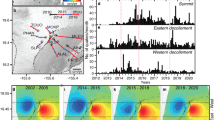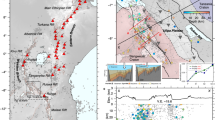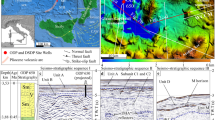Abstract
Seafloor spreading centres show a regular along-axis segmentation thought to be produced by a segmented magma supply in the passively upwelling mantle1,2. On the other hand, continental rifts are segmented by large offset normal faults, and many lack magmatism. It is unclear how, when and where the ubiquitous segmented melt zones are emplaced during the continental rupture process. Between 14 September and 4 October 2005, 163 earthquakes (magnitudes greater than 3.9) and a volcanic eruption occurred within the ∼60-km-long Dabbahu magmatic segment of the Afar rift, a nascent seafloor spreading centre in stretched continental lithosphere3,4. Here we present a three-dimensional deformation field for the Dabbahu rifting episode derived from satellite radar data, which shows that the entire segment ruptured, making it the largest to have occurred on land in the era of satellite geodesy. Simple elastic modelling shows that the magmatic segment opened by up to 8 m, yet seismic rupture can account for only 8 per cent of the observed deformation. Magma was injected along a dyke between depths of 2 and 9 km, corresponding to a total intrusion volume of ∼2.5 km3. Much of the magma appears to have originated from shallow chambers beneath Dabbahu and Gabho volcanoes at the northern end of the segment, where an explosive fissural eruption occurred on 26 September 2005. Although comparable in magnitude to the ten year (1975–84) Krafla events in Iceland5, seismic data suggest that most of the Dabbahu dyke intrusion occurred in less than a week. Thus, magma intrusion via dyking, rather than segmented normal faulting, maintains and probably initiated the along-axis segmentation along this sector of the Nubia–Arabia plate boundary.
This is a preview of subscription content, access via your institution
Access options
Subscribe to this journal
Receive 51 print issues and online access
$199.00 per year
only $3.90 per issue
Buy this article
- Purchase on Springer Link
- Instant access to full article PDF
Prices may be subject to local taxes which are calculated during checkout



Similar content being viewed by others
References
Lin, J., Purdy, G., Schouten, H., Sempère, J.-C. & Zervas, C. Evidence from gravity data for focused magmatic accretion along the Mid-Atlantic Ridge. Nature 344, 627–632 (1990)
Whitehead, J., Dick, J. H. B. & Schouten, H. A mechanism for magmatic accretion under spreading centres. Nature 312, 146–148 (1984)
Barberi, F. & Varet, J. Volcanism of Afar: Small-scale plate tectonic implications. Geol. Soc. Am. Bull. 88, 1251–1266 (1977)
Hayward, N. & Ebinger, C. Variations in the along-axis segmentation of the Afar rift system. Tectonics 15, 244–257 (1996)
Sigmundsson, F. Iceland Geodynamics: Crustal Deformation and Divergent Plate Tectonics (Springer-Praxis, Chichester, UK, 2006)
Hirn, A., Lépine, J.-C. & Sapine, M. Triple junction and ridge hot spots: Earthquakes, faults, and volcanism in Afar, the Azores, and Iceland. J. Geophys. Res. 98, 11995–12001 (1993)
Ruegg, J.-C. et al. First epoch geodetic GPS measurements across the Afar plate boundary zone. Geophys. Res. Lett. 20, 1899–1902 (1993)
Dugda, M. & Nyblade, A. in The Afar Volcanic Province within the East African Rift System (eds Yirgu, G., Ebinger, C. J. & Maguire, P. K. H.) 239–253 (Special Publication, Geological Society of London, 2006)
Kreemer, C., Holt, W. E. & Haines, A. J. An integrated global model of present-day plate motions and plate boundary deformation. Geophys. J. Int. 154, 8–34 (2003)
Michel, R., Avouac, J. P. & Taboury, J. Measuring ground displacements from SAR amplitude images: application to the Landers earthquake. Geophys. Res. Lett. 26(7), 875–878 (1999)
Wright, T. J., Parsons, B. E. & Lu, Z. Towards mapping surface deformation in three dimensions using InSAR. Geophys. Res. Lett. 31, L01607, doi:10.1029/2003GL018827 (2004)
Rubin, A. & Pollard, D. Dike-induced faulting in rift zones in Iceland and Afar. Geology 16, 413–417 (1988)
Abdallah, A. et al. Relevance of Afar seismicity and volcanism to the mechanics of accreting plate boundaries. Nature 282, 17–23 (1979)
Mogi, K. Relations between the eruptions of various volcanoes and the deformation of the ground surfaces around them. Bull. Earthq. Res. Inst. 36, 99–134 (1958)
Okada, Y. Surface deformation due to shear and tensile faults in a half-space. Bull. Seismol. Soc. Am. 75, 1135–1154 (1985)
Wright, T. J., Lu, Z. & Wicks, C. Constraining the slip distribution and fault geometry of the Mw 7.9, 3 November 2002, Denali fault earthquake with Interferometric Synthetic Aperture Radar and Global Positioning System data. Bull. Seismol. Soc. Am. 94(6B), S175–S189 (2004)
Wright, T. J., Lu, Z. & Wicks, C. Source model for the Mw 6.7 23 October 2002 Nenana Mountain Earthquake (Alaska) from InSAR. Geophys. Res. Lett. 30, doi:10.1029/2003GL018014 (2003)
McTigue, D. Elastic stress and deformation near a finite spherical magma body: resolution of the point source paradox. J. Geophys. Res. 92(B12), 12931–12940 (1987)
Delaney, P. & McTigue, D. Volume of magma accumulation or withdrawal estimated from surface uplift or subsidence, with application to the 1960 collapse of Kilauea Volcano. Bull. Volcanol. 56, 417–424 (1994)
Johnson, D., Sigmundsson, F. & Delaney, P. Comment on “Volume of magma accumulation or withdrawal estimated from surface uplift or subsidence, with application to the 1960 collapse of Kilauea Volcano” by P.T. Delaney and D.F. McTigue. Bull. Volcanol. 61, 491–493 (2000)
Nishimura, T. Pressure recovery in magma due to bubble growth. Geophys. Res. Lett. 31, doi:10.1029/2004GL019810 (2004)
de Zeeuw-van Dalfsen, E., Pedersen, R., Sigmundsson, F. & Pagli, C. Satellite radar interferometry suggests deep accumulation of magma near the crust-mantle boundary beneath the Krafla volcanic system, Iceland. Geophys. Res. Lett. 31, doi:10.1029/2004GL020368 (2004)
Hofstetter, R. & Beyth, M. The Afar Depression: interpretation of the 1960–2000 earthquakes. Geophys. J. Int. 155, 715–732 (2003)
Cattin, R. et al. Numerical modelling of Quaternary deformation and post-seismic displacement in the Asal-Ghoubbet rift (Djibouti, Africa). Earth Planet. Sci. Lett. 239, 352–367 (2005)
Keir, D., Ebinger, C., Stuart, G., Daly, E. & Ayele, A. Strain accommodation by magmatism and faulting as rifting proceeds to breakup: Seismicity of the northern Ethiopian rift. J. Geophys. Res. 111, B05314, doi:10.1029/2005JB003748 (2006)
Foulger, G. et al. Post-rifting stress relaxation at the divergent plate boundary in Northeast Iceland. Nature 358, 488–490 (1992)
Pollitz, F. & Sacks, I. Viscosity structure beneath northeast Iceland. J. Geophys. Res. 101(B8), 17771–17794 (1996)
Acknowledgements
Staff at Addis Ababa University, especially L. M. Asfaw, are thanked for their rapid response to the Dabbahu crisis, as are the Ethiopian Air Force for helicopter support. C. Oppenheimer, T. Kidane, A. Philpotts, D. Ayalew, G. Orsi and A. Asrat provided field reports and initial volcanological observations. This report benefited from discussions with B. Parsons, E. Calais, R. Buck, L. Asfaw, C. Wicks and J. Cann. Our work was supported by an NERC urgency grant, Addis Ababa University, the Ministry of Capacity Building of the Ethiopian Federal Government, and the Afar Regional Government. SAR data were provided quickly by the European Space Agency. T.J.W. is funded by a Royal Society University Research Fellowship. Author Contributions T.J.W., C.E., G.Y. and A.A. planned the project; T.J.W. and J.B. processed, analysed and modelled the radar data; A.S., D.K. and A.A. analysed seismic data; G.Y. and C.E. provided petrological and tectonic context; and T.J.W., C.E., D.K. and J.B. wrote the paper.
Author information
Authors and Affiliations
Corresponding author
Ethics declarations
Competing interests
Reprints and permissions information is available at npg.nature.com/reprintsandpermissions. The authors declare no competing financial interests.
Supplementary information
Supplementary Notes
This file contains Supplementary Figures 1–6, Supplementary Tables 1–3 and Supplementary Methods. (DOC 4287 kb)
Supplementary Figure 7
This is a full resolution jpeg of Supplementary Figure 1 showing the wrapped, geocoded interferograms used in this study. KML descriptor files are available at http://www.earth.ox.ac.uk/~timw/dabbahu/, so the images can be viewed in Google Earth. Ascending. (PDF 396 kb)
Supplementary Figure 8
This is a full resolution jpeg of Supplementary Figure 2 showing the wrapped, geocoded interferograms used in this study. KML descriptor files are available at http://www.earth.ox.ac.uk/~timw/dabbahu/, so the images can be viewed in Google Earth. Descending. (PDF 496 kb)
Rights and permissions
About this article
Cite this article
Wright, T., Ebinger, C., Biggs, J. et al. Magma-maintained rift segmentation at continental rupture in the 2005 Afar dyking episode. Nature 442, 291–294 (2006). https://doi.org/10.1038/nature04978
Received:
Accepted:
Issue Date:
DOI: https://doi.org/10.1038/nature04978
This article is cited by
-
Geodynamics of continental rift initiation and evolution
Nature Reviews Earth & Environment (2023)
-
The deep origin of ground fissures in the Kenya Rift Valley
Scientific Reports (2023)
-
Surface fractures generated during the 2021 Reykjanes oblique rifting event (SW Iceland)
Bulletin of Volcanology (2023)
-
Pre-existing fractures and eruptive vent openings during the 2021 Fagradalsfjall eruption, Iceland
Bulletin of Volcanology (2023)
-
The centenary of IAVCEI 1919–2019 and beyond: The people, places, and things of volcano geodesy
Bulletin of Volcanology (2022)
Comments
By submitting a comment you agree to abide by our Terms and Community Guidelines. If you find something abusive or that does not comply with our terms or guidelines please flag it as inappropriate.



